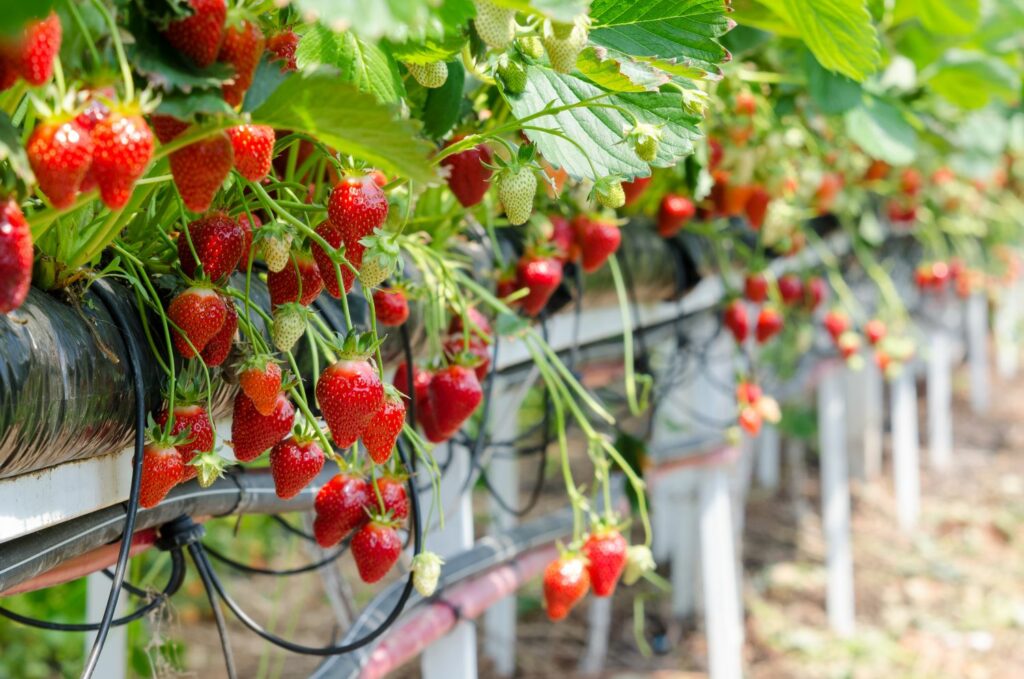Efficient water use equals lower costs and consistent yield quality for soft fruit growers
1st December 2022
At the 2022 NIAB Soft Fruit Day technical webinar, WET Centre operations manager Trevor Wignall outlined the benefits of efficient water use in strawberry crops and shared details of successful research into precision irrigation and rainwater harvesting systems.

Stock photo for illustration purposes only.
Each year, NIAB’s Soft Fruit Day provides growers and the industry with the opportunity to keep abreast with the latest fruit research, learn about new varieties and discover innovative products and technologies.
This year’s event, held as a webinar on 30th November 2022, kicked off with a talk on precision irrigation and other research at NIAB’s WET Centre in East Malling by operations manager Trevor Wignall.
Established in 2017, the centre builds on a hundred years of fruit research and aims to support global food production as the industry moves towards the net zero target. Work at the centre focuses primarily on plant physiology, pest and pathogen ecology and plant breeding.
Optimising plant growth through precision irrigation
According to Mr Wignall, the centre’s strawberry unit consists of eight commercial-scale polytunnels (0.34 ha in total), divided into a Commercial and Advanced area. The latter is equipped with precision irrigation and fertigation systems that work via high-performance sensors and data loggers to ensure optimal moisture and nutrient availability to plants.
Mr Wignall explained precision irrigation has been vital to ensuring the crop’s exact water needs are met, conserving resources and optimising plant health, nutrition, canopy size, yields and fruit quality.
In contrast, timed irrigation systems will always under- or oversupply water as the crop’s water needs can vary up to 13-fold depending on the weather. This not only wastes valuable resources, but can also compromise yields, fruit quality and overall profitability, Mr Wignall said.
To determine the plant’s exact requirements and when to administer water, precision irrigation uses various technologies that provide accurate real-time data. According to Mr Wignall, outdoor sensors monitor environmental conditions such as temperature, light, as well as wind direction and speed.
Whereas, sensors distributed throughout the tunnel measure light levels, humidity, temperature, moisture levels and electrical conductivity in the substrate and runoff volume. The data is then uploaded onto a cloud-based system, allowing researchers to monitor crops remotely and respond promptly to any issues.
Mr Wignall outlined the various benefits precision irrigation systems offer growers, retailers and consumers. Through optimised water use, growers can expect to see consistent yields and fruit quality while saving on water and fertiliser costs. What’s more, a smart irrigation system will allow for improved time management and informed decision-making.
As for retailers, benefits include receiving consistently high-quality, fresh fruit, reduced wastage, and sustainable intensification. Meanwhile, consumers will enjoy fresh fruit that is high-quality, nutritious, and available locally.
In his talk, Mr Wignall also shared results from a survey conducted during the growing seasons of 2011-2013 to demonstrate the significant cost savings that can be achieved through efficient water use. According to the survey, growing systems using precision irrigation produced twice as much fruit for the same amount of water as traditional systems.
Moving towards self-sufficiency with rainwater harvesting
Next, Mr Wignall provided some insight into a research project investigating rainwater harvesting (RWH) systems at the WET centre. The primary objectives of the project were to identify the benefits and limitations of RWH and determine whether the centre could become self-sufficient using the system.
Mr Wignall emphasized that water use is becoming more important due to climate change and the increased frequency of droughts in recent years. The issue is especially relevant to the soft fruit sector, which has evolved away from soil-grown crops towards using substrates such as coir.
While substrates offer a number of benefits such as lower pest and disease pressure, they also significantly increase water use as the crops don’t have access to water residues found in the soil. With the cost of water also increasing, the efficient use of available resources is even more important in these growing systems, Mr Wignall said.
According to the results of the project, using RWH at the WET Centre achieved 47% self-sufficiency, with 0.172 ha served out of 0.34. Whereas, the centre’s Advanced area was 88% self-sufficient. The researchers concluded that a full 400 m3 storage tank would be required to cover all of the centre’s water needs.
What’s next for the WET Centre?
Before finishing his talk, Mr Wignall briefly spoke of the current research that is being carried out at the WET Centre. Some of the ongoing projects are looking at how to optimise light for crops grown in polytunnels and using biostimulants to improve plant performance in low-input systems.
The centre also has plans for trialling an AI-driven “smart” venting control system to optimise the phystoclimate in polytunnels. Other areas of research include reusing growing media, transitioning to net zero, targeted nutrition applications and yield forecasting models.
